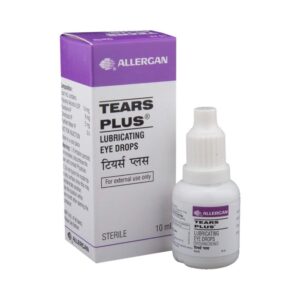POLYVINYL ALCOHOL + POVIDONE + CHLORBUTANOL
Polyvinyl Alcohol: Polyvinyl alcohol is a synthetic compound that is used in a variety of applications, including as a pharmaceutical drug. It is commonly used as a lubricant and wetting agent in eye drops and artificial tears.
The mechanism of action of polyvinyl alcohol in eye drops is to provide lubrication and moisture to the surface of the eye. It helps to relieve dryness, itching, and discomfort caused by various factors such as environmental conditions, certain medications, or extended periods of computer use.
When used as eye drops, the recommended dose of polyvinyl alcohol is typically one to two drops in each affected eye, up to four times a day, or as directed by a healthcare professional. It is important to follow the recommended dosage instructions and not exceed the prescribed amount.
Although polyvinyl alcohol eye drops are generally well-tolerated, some potential side effects may occur. Common side effects include temporary burning or stinging sensation in the eyes, blurred vision, and increased sensitivity to light. These side effects are usually mild and transient. However, if any of these side effects persist or worsen, it is advisable to consult a healthcare professional.
In rare cases, some individuals may experience an allergic reaction to polyvinyl alcohol. Symptoms of an allergic reaction can include severe itching, redness, swelling, or rash. If any of these symptoms occur, it is important to seek immediate medical attention.
Overall, polyvinyl alcohol is a commonly used drug in eye care that provides temporary relief from dryness and discomfort. However, it is important to use it as directed and consult a healthcare professional if any concerns or side effects arise.
Povidone: Povidone, also known as polyvinylpyrrolidone or PVP, is a synthetic polymer that is used as an ingredient in various pharmaceutical and healthcare products. It is commonly used as a binder, stabilizer, or dispersing agent in tablets, creams, ointments, eye drops, and other formulations.
The main mechanism of action of povidone is its ability to form complexes or molecular associations with other substances. It acts as a film-forming agent, creating a protective layer that enhances the stability and bioavailability of the active ingredients in drug formulations. Povidone is also known for its ability to absorb water, making it useful for creating suspensions or solutions.
The dose of povidone can vary depending on the specific product and its intended use. It is typically used in concentrations ranging from 2% to 30% in topical formulations and as a tablet binder at concentrations of 2% to 5% or higher.
Povidone is generally considered safe when used as directed. However, some people may experience mild skin irritation or allergic reactions when using products containing povidone. Rarer side effects may include skin rash, itching, or peeling. If any allergic reaction or severe side effects occur, it is important to seek medical attention immediately.
It is worth noting that povidone is well tolerated by most individuals and has a low risk of systemic absorption. It is not known to interact with other medications, but it is always advisable to consult a healthcare professional before using any new products, especially if you have any preexisting medical conditions or are taking other medications.
Chlorbutanol: Chlorbutanol, also known as trichloroethanol, is a medication primarily used as a sedative, hypnotic, and anesthetic agent. It is classified as a type of alcohol derivative and is available in various formulations, such as oral solutions, rectal suppositories, and topical creams.
The exact mechanism of action of chlorbutanol is not fully understood. However, it is believed to exert its sedative and hypnotic effects by acting on the central nervous system. It is thought to enhance the inhibitory effects of the neurotransmitter gamma-aminobutyric acid (GABA), resulting in decreased neuronal activity and induction of sedation and sleep.
The recommended dose of chlorbutanol may vary depending on the specific formulation and the individual patient’s needs. In general, for oral solutions, the usual dose is 250 to 500 mg, taken before bedtime as needed. For rectal suppositories, the dose ranges from 125 to 250 mg, also administered before bedtime. It is important to follow the instructions provided by the healthcare professional or indicated on the product label.
Like any medication, chlorbutanol has potential side effects. Common side effects may include drowsiness, dizziness, headache, and dry mouth. Some individuals may experience allergic reactions, such as rash, itching, or swelling. It is important to seek medical attention if any severe side effects occur, including difficulty breathing, chest pain, or unusual bleeding or bruising.
Chlorbutanol should be used with caution in individuals with a history of alcohol or substance abuse, liver or kidney disease, or respiratory conditions. It is not recommended for use in pregnant women or nursing mothers, as its safety in these populations has not been well-established.
As with any medication, it is important to consult a healthcare professional before starting chlorbutanol to ensure its safe and appropriate use, especially if you have any underlying medical conditions or take other medications.

